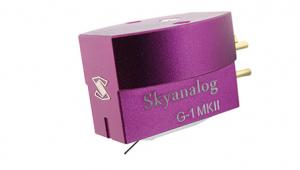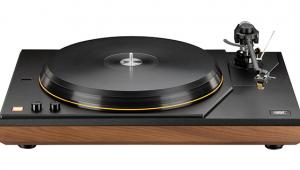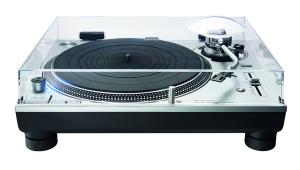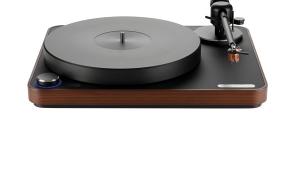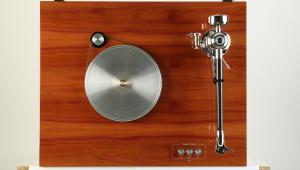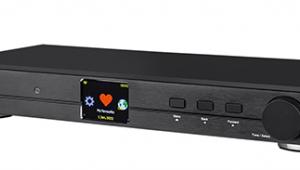Clearaudio Innovation (£11,770)
Unruffled by the conflicting diversity of the turntable world, Clearaudio has carefully evolved its own design precepts with little regard for peer pressure or pseudo-technical fashion trends. The result is a model line-up that offers a convincing hierarchy of performance and price.
So if you start at the bottom of the Clearaudio Solution range, you can upgrade with a thicker platter, a doubled-up chassis, and so on. You might never reach the top of the line, which is the three-motored, parallel-tracking-armed Master Reference. It’s a bit like the way that as a boy you could upgrade your too-small Meccano outfit, adding a few gears and maybe a clockwork motor, while really dreaming of owning the Set 10.
But now there’s a new encouragement to go straight to somewhere near the top, if you can. Clearaudio’s Innovation turntable is founded on the proven building-blocks of existing designs, yet launches a fresh concept of what a high-end turntable should be.
It’s founded on a doubled-up version of Clearaudio’s sandwich construction chassis; the elegant curves are emphasised by the contrast of the polished metal edges and glossy black acrylic. Other surfaces are matt rather than gloss black, giving a pleasing effect. Compared with the Solution models, the Innovation gains a kind of classic simplicity from the fact that the motor is housed in one of the three towers, rather than standing free between two of the chassis lobes.
Providing a compatible ‘dead’ surface for the disc is the 70mm-thick black Delrin (POM) plastic main platter. This rests on the lower part, a 15mm-thick disc of stainless steel. Hidden beneath that is the Innovation’s special new feature, the Optical Speed Control or OSC, said to give better speed stability than ever before. There’s nothing new about the basic idea, as feedback or servo-based speed control was common on direct-drive decks around 30 years ago, and was also applied to
belt-drives. But I think Clearaudio is the first to make it work in an audiophile context.
In the centre of the platter is what could be called Clearaudio’s previous big innovation, the patented Ceramic Magnetic Bearing. The platter’s weight is supported, frictionlessly, by the mutual repulsion of two rings of opposing magnets, mounted on the chassis and on the lower platter. The magnetic elements are designed to give a field that is well contained, and the non-magnetic ceramic shaft means no magnetic effects can reach the surface of the platter.
PRECISION TONEARM
Clearaudio is an advocate of parallel- or radial-tracking arms, but here we were provided with its top pivoted arm, the Universal. This lives up to its name, coming with no fewer than four different counterweights; so by choosing the right one you can comfortably balance out cartridges weighing as little as three or as much as 22 grams. With its beautiful pearl/matt chrome finish, thumbwheel control and engraved scale, the back end of the arm has the engineering aura of a classic Moore & Wright micrometer.
While Clearaudio’s other pivoted arms have jewel bearings, the Universal uses miniature ballraces. Fitted below the main bearing housing is Clearaudio’s VTA Lifter, a lever device which allows fine adjustment of arm pivot height while playing. The arm tube is of carbon fibre.
Completing our package was the da Vinci cartridge, which comes in below the Titanium and Goldfinger models but uses the same Micro HD stylus. For this model, that distinctive amoeba-shaped body is anodised aluminium (rather than titanium or gold). The long boron cantilever looks alarmingly unprotected as it projects from the nose of the generator assembly, but Clearaudio comforts the nervous with a well-designed stylus guard. You can even set the alignment and check the azimuth with the guard on.
You might think that the cartridge was made that shape just to make it difficult to align with a setup protractor, but in fact, as with so many other design aspects, the aim was control of resonances. I think it must have been successful. Cartridges usually produce some ‘needle talk’, playing faint but recognisable music by mechanical vibration, but with the da Vinci in this arm there was practically none. The arm should take some credit too, because when fitted in another make of arm, the da Vinci was not quite as silent, though still very much quieter than normal.
CONTROLLED BASS
If you are inured to the common species of hi-fi bass, as opposed to the natural kind, you will immediately appreciate the controlled and extended bass of the Innovation. I started with Eric Clapton’s 1977 Slowhand [RSO 2479 201] where that lower-end clarity was a real benefit, in fact a necessity. There was a big, fat bass sound when it was needed but the overall effect was never just dragged down to a muddy bottom, as it so easily can be with this album. So the urgent shuffle beat of ‘Lay Down Sally’, with such great drumming by Jamie Oldaker, came over fairly well. With the Harry James band and The King James Version [Sheffield Lab
LAB-3], once again, the bass was both tight-sounding and absolutely free of boom, so that you could always hear the way that bass lines underpinned the music harmonically, as well as keeping time. In the mid and treble, brass sounds were clean and well defined while the saxes were full of character, creating an inviting and engaging effect. There was a great sense of space in terms of both width and depth, so you got an exceptionally good feeling of the layout of the brass and sax sections, the band now realistically spread within the acoustic.
On the mid-tempo blues, ‘More Splutie Please’ Harry James’ terse and spitty trumpet solo came barking out just as if he was standing in front of you. On this justly-celebrated direct cut, the Clearaudio really did convey a sense of occasion.
Next came Jennifer Warnes’ ‘Ballad Of The Runaway Horse’ from the Rob Wasserman Duets album [GRP 97-121]. Here Warnes’ voice was full of subtleties, sinuous, controlled, yet still expressive. More than ever, perhaps, I found myself trying to analyse the artful production tricks which went into making this seemingly quite straightforward track – for example, the way Warnes’ voice is placed quite forward at first, then seems to fall back slightly, and the way Wasserman’s bass also gets a little quieter, to fall back a little at key moments.
Continuing with female vocals, but of a very different kind, Tracy Chapman [Elektra 960 774-1] provided another example of the ability to produce a big, wide image spread with a strong, tangible central vocal image. Here the singer’s unaccompanied ‘Behind The Wall’ was truly gripping, and she was warm and timelessly moving on ‘Baby Can I Hold You’.
I think the turntable excelled itself with Dire Straits from 1978. On ‘Sultans of Swing’, you could come perhaps almost as close as it’s possible get to unravelling the rhythm guitars, which filled out a wide and solid stereo image, with vocal and lead guitar firmly centred and presented with delightful clarity. Every detail of Knopfler’s diction was laid bare, his voice truly characterful and not merely gruff, and his guitar wizardry soaring and effortless.
Turning to classical music, I found myself swept away again by a favourite from 1967, Barenboim with the English Chamber Orchestra in that most familiar Mozart piano concerto, No.21 [EMI ASD 2465]. For some reason this seemed to come alive in a quite special way on this turntable. At the bottom end, the foundations seemed solid and firm, with double-basses that could be heard properly. In the lower mid, the bassoon sounded truly fruity, while in the upper mid and treble the strings were bright but presented with tangible detail, and so never sounded unpleasantly coarsened or really harsh. The piano was believable from bottom to top, with a sprightly, intimately tactile quality, keeping its sonic integrity against the orchestra, which surrounded it quite realistically without swamping it or sounding congested.
Ultimately, I’m not sure this is really the ultimate turntable for rockers, but on music where the inner space is more important than the edge, it shines every time.
VERDICT
This package gave a very stable, controlled sound, perhaps balancing the dynamic punch of the da Vinci cartridge against the well-damped, low-resonance character of the turntable. It also proves that Clearaudio’s turntables look just as good in black as, er, in the clear. However, the costlier Innovation Wood, with acrylic rather than POM platter, provides a visual and sonic alternative.
This review was originally published in the September 2009 issue.







